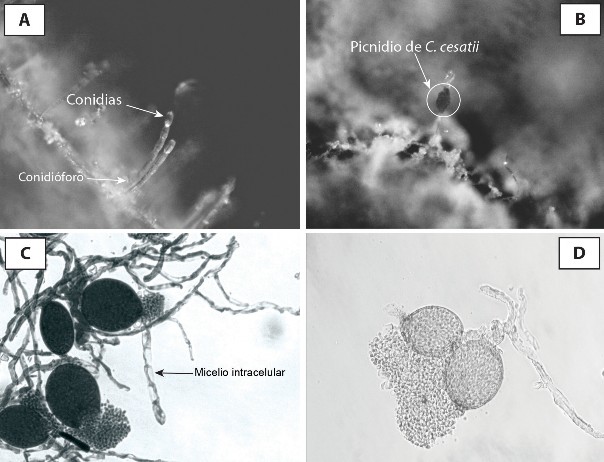Bioprospecting hyperparasites Cicinobolus cesatii de Bary y Eudarluca caricis (Biv.) O.E. Erikss in crops and adjacent plants in Central Region of Guatemala
DOI:
https://doi.org/10.36829/63CTS.v1i1.10Abstract
Bioprospecting was performed to detect hyperparasites Cicinobolus cesatii and Eudarluca caricis in central region of Guatemala to establish their presence and obtain promising strains to be use in biological control. Seven hundred and six samples from wild and cultivated plants were analyzed; C. cesatii was detected in 16 samples, and 46 cases of E. caricis. Both hyperparasites were identified in San Juan Comalapa and Tecpan of Chimaltenango County, having high biological potential and variability. Reproductive structures comparison of the different isolates was made and its variability was established through statistical analysis showing significant differences when they were compared between strains from the same site and between sites, also they showed difference between plant origins. These strains such as C. cesatii from Physalis sp. and E. caricis from Prunus sp., Zea mays, and Phaseolus vulgaris have a high potential. This research showed a high presence of both agents on wild plants or areas without application of fungicides.
Downloads
References
Alvarez, G., y García, E. (1993). Manejo Integrado de Arveja China: fase I 1991-1992. Guatemala: Ministerio de Agricultura Ganadería y Alimentación.
Black, A. (2012). The epidemiology of Puccinia emaculata (rust) in switchgrass and evaluation of the mycoparasite Sphaerellopsis filum as a potential biological control organism for switchgrass rust. (Master's Thesis). University of Tennessee. Recuperado de http://trace.tennessee.edu/utk_gradthes/1251
García, J. (2000). Determinación de enfermedades fun- gosas en el tejido aéreo de 30 especies de plan- tas medicinales en dos localidades del Altiplano Central de Guatemala (Tesis de Licenciatura). Facultad de Agronomía, Universidad de San Carlos de Guatemala, Guatemala.
Goh, T. K. (1999). Single-spore isolation using a hand- made glass needle.Fungal Diversity, 2, 47-63.
Guerra, T. (2005). Informe final de Diagnostico, Ser- vicios e Investigación desarrollados en el Centro de Diagnóstico Parasitológico de la Facultad de Agronomía, Universidad de San Carlos de Gua- temala. (Tesis de Licenciatura). Facultad de Agro- nomía, Universidad de San Carlos de Guatemala, Guatemala.
Instituto Nacional de Estadística. (2004). IV Censo Agropecuario Nacional. Guatemala: Autor.
Keener, P. (1934). Biological Specialization in Darlucafilum. Bulletin of the Torrey Botanical Club. Torrey Botanical Society, 61(9), 475-490. https://doi.org/10.2307/2480811
Kranz, J., & Brandenburger, W. (1981). An amended host list of the rust parasite Eudarluca caricis. Journal of Plant Diseases and Protection, 8(11), 682-702.
Liesebach, M., & Zaspel, I. (2004). Genetic diversity of the hyperparasite Sphaerellopsis filum on Melampsora willow rusts. Forest Pathology, 34(5), 293-305. https://doi.org/10.1111/j.1439-0329.2004.00369.x
Mejía, L. (2008). Diagnóstico de enfermedades en mues- tras analizadas en el Centro de Diagnóstico Para- sitológico de la Facultad de Agronomía, Universi- dad de San Carlos de Guatemala y Laboratorio de Diagnóstico Fitosanitario de la Unidad de Normas y Regulaciones, Ministerio. (Tesis de Licenciatu- ra). Facultad de Agronomía, Universidad de San Carlos de Guatemala, Guatemala.
Plachecka, A. (2005). Microscopical Observations of Sphaerellopsis filum, a parasite of Puccinia recondita. Acta Agrobotanica, 58, 67-71. https://doi.org/10.5586/aa.2005.010
Sucharzewska, E., Dinowska, M., & Bozena, A. (2011). Ocurrences of the fungi from the genus Ampelomyces - Hiperparasites of powdery mildews (Erysiphales) infesting trees and bushes in the municipal environment. Acta Societatis Botanicorum Poloniae, 80, 169-174. https://doi.org/10.5586/asbp.2011.027
Sztejnberg, A., Galper, S., & Lisker, N. (1990). Conditions for pycnidial production and spore formation by Ampelomyces quisqualis.Canadian Journal of Microbiology, 36, 193-198. https://doi.org/10.1139/m90-033
Sztejnberg, A., Galper, S., Sholomit, M., & Lisker, N. (1989). Ampelomycs quisqualis for biological and integrated control of powery mildews in Israel. Journal of Phytopathologoy, 124, 285-295. https://doi.org/10.1111/j.1439-0434.1989.tb04925.x
Yuan, Z. W., Pei, M. H., Hunter, T., & Royle, D. (1998). Eudarluca caricis, the teleomorph of the mycoparasite Sphaerellopsis filum, on blackberry rust Phragmidium violaceum. Mycology Research, 102, 866-868. https://doi.org/10.1017/S0953756297005832

Downloads
Published
How to Cite
Issue
Section
License
Copyright (c) 2014 Gustavo Adolfo Alvarez Valenzuela, María del Carmen Santos Bravo, Luis Fernando Centes Carrillo

This work is licensed under a Creative Commons Attribution-NonCommercial-ShareAlike 4.0 International License.
El autor que publique en esta revista acepta las siguientes condiciones:
- El autor otorga a la Dirección General de Investigación el derecho de editar, reproducir, publicar y difundir el manuscrito en forma impresa o electrónica en la revista Ciencia, Tecnología y Salud.
- La Direción General de Investigación otorgará a la obra una licencia Creative Commons Atribución-NoComercial-CompartirIgual 4.0 Internacional









